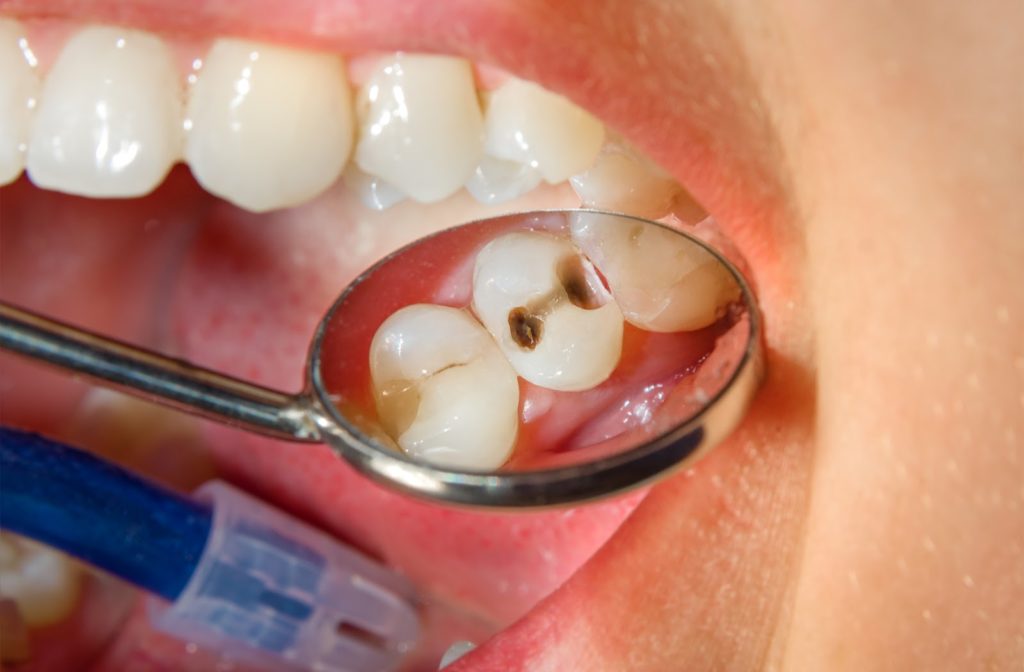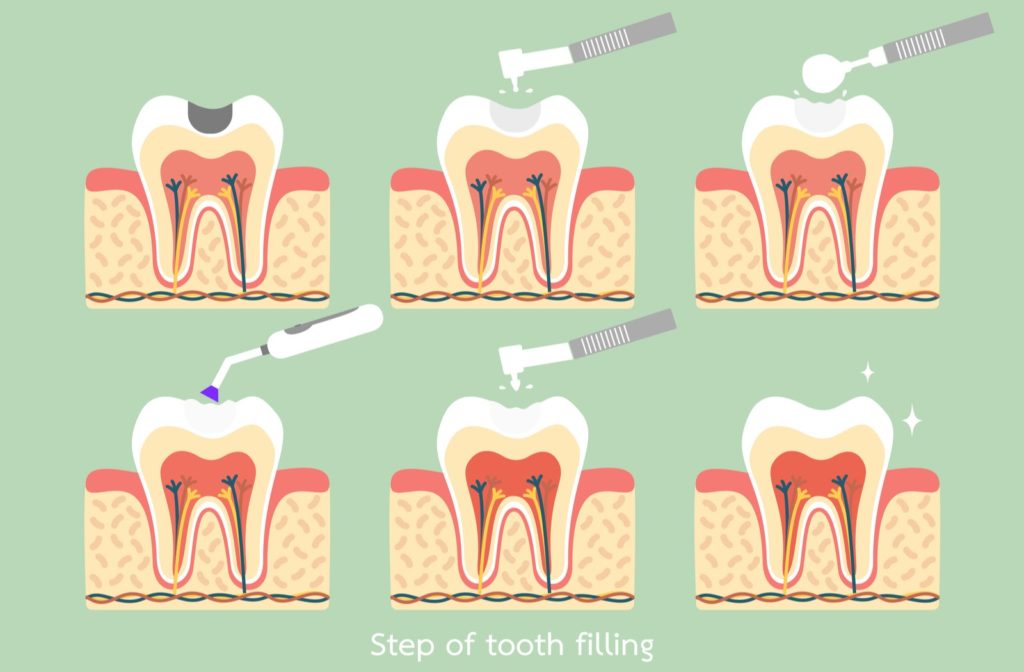No one likes having cavities, but lots of people get them anyway—one reason why is that people don’t always understand how cavities develop. Seeing your dentist for regular cleanings can undoubtedly help prevent cavities, but it’s also a good idea to learn more about them so that you know what to do if they show up.
One common question we get at Southgate Dental is whether or not fillings fix cavities. Don’t worry — by the time you’ve finished the next few paragraphs you’ll know a lot more than that about this pesky form of tooth decay. Enjoy our comprehensive guide on what causes cavities, along with information about how you can deal with them.

The Root Causes of Cavities
Cavities occur when tooth decay causes small holes to form in the enamel coating your teeth. If left unchecked, these holes can also reach through the layer of dentin underneath the enamel and eventually penetrate all the way to the pulp inside your teeth.
You might be wondering what causes tooth decay in the first place. The answer is: bacteria. Bacteria collect in your mouth to feed on the sugars and starches left behind when you don’t clean your teeth effectively. They can also form layers of plaque and tartar, which shields them as they wear away your enamel. Whether you brush your teeth or not, plaque will form on your teeth every 24 hours.
Poor dental hygiene and starchy or sugary diets can certainly contribute to cavities, but there are other risk factors as well. Here are some additional signs that you may be more likely to develop cavities in your teeth:
- You snack frequently throughout the day, giving bacteria longer intervals to develop between brushings. Every time you eat, the bacteria in your mouth become hyperactive for about 20 minutes, producing more acid, which can lead to cavities.
- You don’t use enough fluoride, which aids in preventing cavities and can even help fix early tooth decay. Many cities add fluoride to their water systems, but fluoridated water is only really helpful when children’s teeth are developing. As soon as children can spit out toothpaste, they should be using toothpaste with fluoride.
- You have receding gums, which exposes your tooth’s root. Roots are more susceptible to decay, because they don’t have hard enamel like teeth do. Gum recession usually happens as a result of brushing too hard or not brushing enough.
- You use medications that include reduced saliva as a side effect, or have a naturally dry mouth. Saliva helps prevent cavities by flushing food and bacteria out of your mouth.
- You wear an old retainer or other dental devices. Dentures, retainers, and other such devices can easily trap bacteria underneath them if they aren’t snugly fitted to your teeth.
- You have fillings, crowns, or bridges. Fixed dental devices can easily collect bacteria around the edges, so they require extra attention when brushing and flossing.
- You experience acid reflux from heartburn or vomit frequently. Your stomach acid can easily wear away tooth enamel, causing or exacerbating cavities.
Young people may also be at higher risk for cavities, perhaps since they may be more likely than adults to consume sugary snacks and snack more often. Infants may also experience cavities if their mothers feed them before bed, since bacteria from milk or juice can stay on their teeth during the night.
Cavities are more likely to form on the molars before appearing on the front teeth, since their grooved surface and placement within the mouth make them harder to clean.
What Do Fillings Do?
Dental fillings replace lost pieces of tooth structure with artificial material. They are usually made from one of several materials:
- Gold
- Porcelain
- Silver amalgam (containing silver, zinc, copper, and tin mixed with mercury)
- Composite resin made from ceramic and plastic
Fillings made from different materials are likely to vary in price and longevity. If you need fillings, it’s vital to discuss each of these options with your dentist and let them recommend a choice based on your needs and resources.

How Do Fillings Work?
When your dentist fills a cavity, they’ll generally go through the following steps:
- The dentist numbs the area around the damaged tooth and the tooth itself with an anesthetic
- The dentist uses a laser or drill to remove the part of the tooth that has decayed
- The dentist clears leftover material and bacteria out of the cavity
- The dentist inserts the filling (sometimes with a liner to protect the nerve if the cavity has reached down near the pulp)
- The dentist finishes and polishes the cavity
Will Fillings “Fix” Cavities?
Adding dental fillings to teeth can prevent the tooth decay in those areas from progressing. However, it is vital to understand that decay can still occur in the rest of the tooth. If the area surrounding the filling decays, the filling can come loose and even fall out, exposing the damaged area all over again.
The bottom line? Fillings replace lost tooth structure, but they don’t strengthen your tooth. In fact, fillings actually make teeth weaker. The best course of action is preventing cavities in the first place as teeth with cavities are more likely to facture and require further dental work like a root canal or implant down the road.
You should get your cavities filled, but don’t use your new fillings as an excuse to slack off when it comes to dental hygiene. Keep brushing and flossing regularly, use mouthwash with fluoride, and be careful what you eat.
Let Your Dentist Help You
Remember: even if you care diligently for your teeth, cavities can still appear. Visiting your dentist for regular cleanings and x-rays are an excellent way to monitor your mouth for cavities and act decisively if they are developing.
The smaller the cavity is, the easier it is to fill, so make sure you get fillings as soon as possible!


